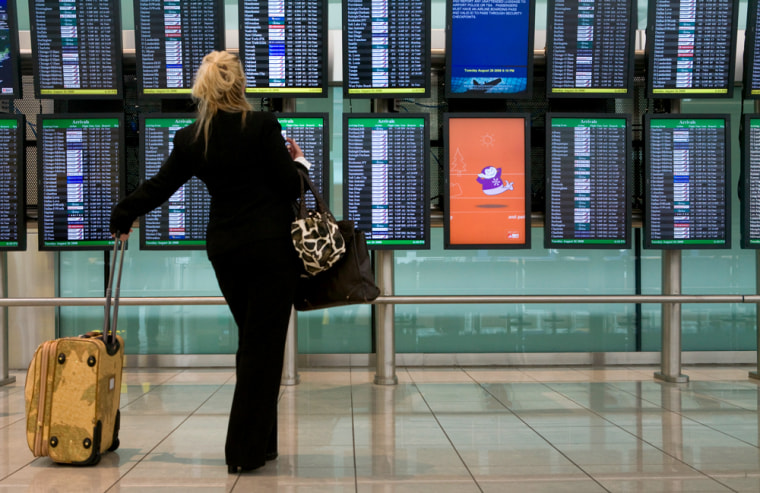For those keeping score at home: Last week, Congress extended funding for the Federal Aviation Administration (FAA). Extending the rights of airline passengers, not so much.
As noted in this space last week, the split decision came down to stripping out previously proposed language that would have established a passengers’ bill of rights. Proponents were understandably upset; industry members were presumably pleased, and the issue is probably off the Congressional agenda until next spring.
All of which serves as a telling backdrop for passenger-protection proposals currently being considered by the Department of Transportation (DOT). With new reporting rules on tarmac delays going into effect this week and winter weather around the corner, inquiring minds want to know: Will DOT do what Congress could not?
Grounded for hours — but not delayed?
The latest rule, effective October 1, requires airlines to report additional information on tarmac delays and closes a loophole that skewed the existing data on canceled and diverted flights. It was conceived in the wake of the serial meltdowns that subjected thousands of passengers to onboard delays of four or more hours in December 2006 and February 2007.
Amazingly enough, under current rules, those flights weren’t considered delayed at all. (Those stuck on board may beg to differ.) As soon as a flight was canceled or diverted, the airlines were no longer required to record it as delayed. At that point, says Sam Podberesky, DOT’s assistant general counsel for aviation enforcement, “All the information regarding tarmac delays disappeared into the system.”
The new rule, he says, requires carriers to report additional data points that will track a flight’s progression even if it’s canceled or diverted: “If an airline pulls back from the gate, sits on the tarmac for five hours and then gets canceled, that five hours will now show up in the delay statistics. [The flight] will also show up as canceled.”
It’s an incremental improvement at best, and the enhanced data should begin appearing in early December. “The Department thinks that the number of flights that will be affected by this rule change is extremely small,” says Podberesky. “The main benefit we’ll get out of it is that we’ll get more complete data on tarmac delays.”
So, yes, capturing the data is a good thing. Sparing passengers from becoming data points in the first place would be infinitely better.
Who decides when passengers can deplane?
That, in fact, is the subject of deliberations currently going on at DOT. Last year, the department sent out a request for comments on proposed rules that would, among other things, require airlines to adopt contingency plans for lengthy tarmac delays and incorporate them into their contracts of carriage.
Several airlines already have such contingency plans in place, and a few — notably, Hawaiian, JetBlue and Southwest — actually include a specific timeframe for deplaning passengers in their contracts of carriage (subject to conditions). Most, though, include such information in their customer service plans, which, as any government lawyer, industry lobbyist or airline executive can tell you, is another issue entirely. As airline spokespeople are fond of saying, you can’t legislate customer service.
Personally, I always thought they were stating a simple principle of market economics: Buyers (that’s us) will determine the value of competitors’ products (be they pillows, plane tickets or a pleasant experience) and then patronize sellers (that’s the airlines) who provide them at an acceptable price. There’s no need for legislation when the laws of the marketplace work.
But they don’t mean you can’t legislate customer service as in you shouldn’t legislate it, but rather, as in you can not because you don’t have the regulatory authority to do so. As part of a customer service plan, an airline can have every intention of letting passengers deplane during an extended delay, but there’s no breach of contract if it doesn’t. That’s why they call them customer service plans, not customer service contracts.
The devil is in the details
The question, then, is will DOT require the airlines to turn their (presumably good) intentions into enforceable action plans? “We’ve proposed that the airlines be contractually bound to let passengers off after ‘X’ number of hours,” says DOT General Counsel D.J. Gribbin, which would entail codifying their contingency plans in their contracts of carriage. Assigning a specific value to X — two hours, four hours, whatever — will likely be left up to the individual airlines.
The key word, of course, is “proposed,” and DOT is expected to release a proposed notice of rulemaking sometime in November or December, at which point interested parties will be invited to submit comments. A final rule could be issued by spring, although Gribbin cautions that “the process carries with it the assumption that the department is open to not doing a rule at all.”
Which certainly puts an interesting spin on the old saw about how the wheels of government grind exceedingly slow. When they finally stop, will they have produced something fine or just crushed our hopes again?
